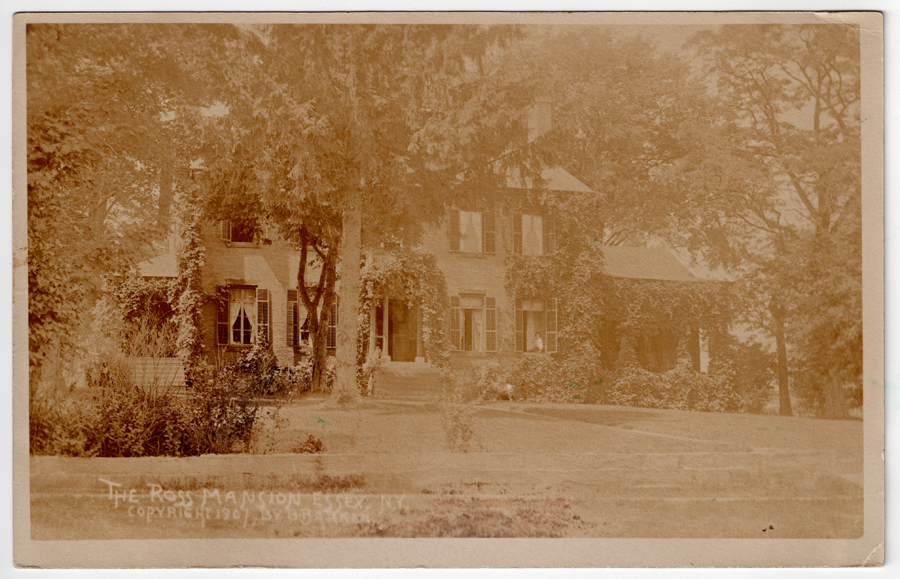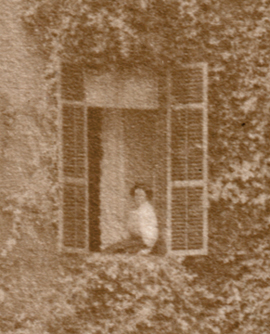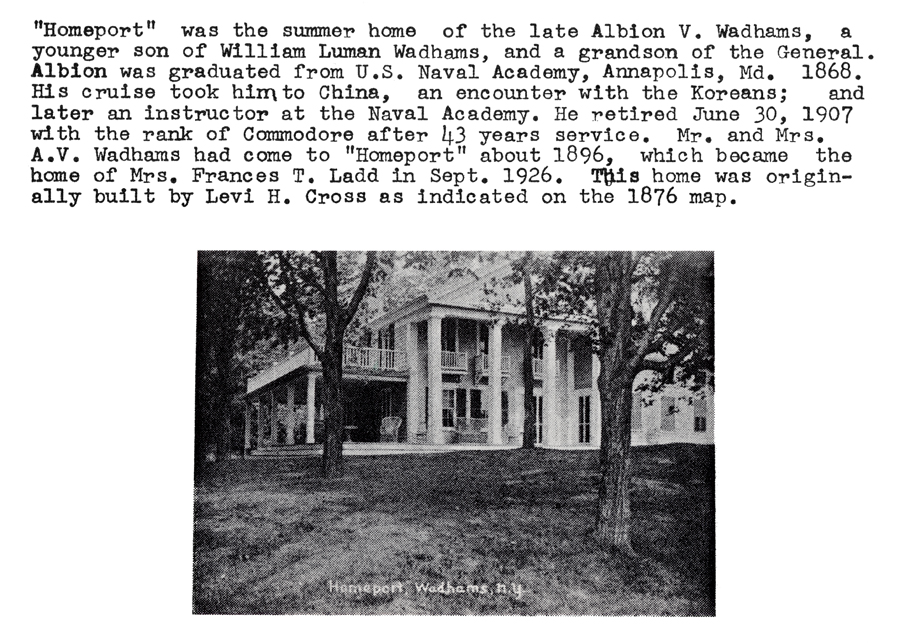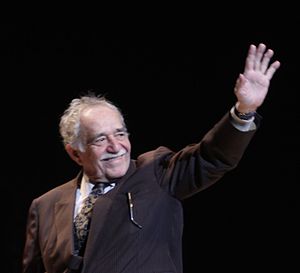
Rosslyn artifacts continue to emerge, and sometimes they’re not even even Rosslyn artifacts at all but Ross family artifacts. For example, I just discovered this antique postcard of the Ross Mansion (aka Hickory Hill) which was built in the early 1820s by the brother of W.D. Ross, the original owner of Rosslyn. Here’s the description provided by friend and Essex neighbor, Catherine DeWolff:

Real photo postcard of the Ross Mansion in Essex, New York, on beautiful Lake Champlain – copyright 1907 by B. Benton Barker of Burlington, Vermont – faded card but details are still discernible such as Mrs. Ross sitting in her window (it is well known in the town history that that window was her favorite sitting spot and some say she still can be seen sitting there) – corners are lightly bumped and rubbed with a minor double crease at the bottom right corner – divided back is unused – rare barker card is comes in a rigid plastic display holder. (Catherine DeWolff)
Mrs. Ross’s lingering spirit was news to me. Looks like time for a little investigative work! It would be good indeed to collect a firsthand account from one who’s witnessed Mrs. Ross occupying her favorite window seat a century and change after this photograph was taken.
Hickory Hill with Tilly Close
This past summer I was fortunate to meet Tilly Close for a tour of Hickory Hill which was built by her great grandfather, Henry Howard Ross. H.H. Ross (as local historians usually remember him) was William Daniel Ross’s brother. W.D. Ross (clearly historians and archivists had a vested interest in typographical efficiency) built Rosslyn in 1822, at the same time that his brother was building Hickory Hill.
[pullquote]The family was lacking in imagination when naming their children. There were three Henry Howard Ross men, creating much confusion.[/pullquote]
Although Mrs. Close shared plenty of anecdotes about Hickory Hill, there was no mention of ghosts.
From what I can ascertain, both Daniel Ross and his bride Elizabeth Gilliland Ross Evertson died at Hickory Hill, but the latter passed away on August 3, 1847, well shy of B. Benton Barker’s 1907 photograph. Perhaps Mrs. Close can shed some light on the window sitting phantom. Her crisp sense of humor and encyclopedic recollection (including extensive genealogical research) have proven to be the single best guide in sorting out Ross family history. When I asked her to verify that Hickory Hill’s builder, H.H. Ross, had been her great grandfather she responded promptly as follows:
The family was lacking in imagination when naming their children. There were three Henry Howard Ross men, creating much confusion. H.H. Ross who built Hickory Hill was the son of Daniel Ross (who was married to Gilliland’s daughter Elizabeth). Henry’s brother, William D. Ross… built your home. His son, H.H. Ross was born 10/23/1827 – 6/15/1908. He married Mary Julia Nichols. Hickory Hill Henry Ross had 8 children. His son James Blanchard Ross who built the Camalier’s house, had a son named H.H. Ross, who married Anna Noble, and died early 1857-1882. (Tilly Close)
In a subsequent communication Mrs. Close explained further:
My Great Grandparents, Henry and Susannah had 8 biological children, plus one adopted girl, whose mother was Susannah’s sister, and had died. One of their sons is named William Daniel Ross II, born 10/5/1830 and died as a soldier in the Civil War, in Washington, DC 10/25/1861. I have his portrait by Horace Bundy. Rosslyn, which I think was called Hyde Gate at one point, was built by my Gr. Grandfather’s brother, W.D. Ross… (Tilly Close)
An abundance of H.H. Rosses, a pair or W.D. Rosses and a fetching ghost by the name of Mrs. Ross. All the ingredients for a thriller!
Haunting Hickory Hill & Rosslyn
[pullquote]It strikes me as unlikely that almost two centuries would fail to produce a ghost or two.[/pullquote]
I’m still hunting for evidence of a ghostly Mrs. Ross haunting the halls (or windows)of Hickory Hill. And what about Rosslyn’s spiritual dimension? My bride claims psychic faculties and denies the presence of ghosts in our home. But it strikes me as unlikely that almost two centuries would fail to produce a ghost or two.
During Rosslyn’s renovation, several contractors mentioned signs of a ghost on the third floor. For my part, I can not confirm any lingering spirits, but maybe the prolonged renovation process sent them scampering for more congenial circumstances. The endless whine of saws and the thwump-thwump of hammers may have driven Rosslyn’s ghosts up to Hickory Hill! But I’ll continue to poke around, and I promise to share any spooky discoveries.
From Hickory Hill to Homeport
A recent eBay find took me even further afield than Hickory Hill. In fact, it’s not really a Rosslyn artifact at all. I include it here because it pertains to another house which indirectly influence my compunction to purchase and renovate Rosslyn. Although my earliest childhood memories derive from The Farm, I spent far longer living in a subsequent home in Wadhams, New York.

By way of an eBay seller in Bonita Springs, Florida I was able to acquire a history of Wadhams entitled In the Beginning… Wadhams 1820-1970 which was compiled and published by Ethel L. Kozma.
[pullquote]The elegant home enchanted my parents, and they undertook a renovation very nearly as ambitious as our own. I grew up in the midst of it, obviously distorting my understanding of a “fixer upper” and my notion of a prudent investment.[/pullquote]
Nestled amid Wadhams history, genealogy and photographs, this image of the home where I lived during my elementary school years immediately triggered a flood of memories. Although I was too young to actually participate, my parents renovated this “once stately mansion” (cribbed from the original real estate listing) despite many decades of neglect and dilapidation. The left side of the porch in the image above had long since been removed, but the elegant home enchanted my parents. They undertook a renovation very nearly as ambitious as our own. And I grew up in the midst of it, obviously distorting my understanding of a “fixer upper” and my notion of a prudent investment.
Haunting Homeport
Although I don’t recall any ghosts haunting our home in Wadhams, I did have an imaginary friend (two actually, if you count my imaginary friend’s imaginary friend) with whom I adventured and conspired. Those were enchanted years that might have proven even more so if I’d known the house’s history:
“Homeport” was the summer home of the late Albion V. Wadhams, a younger son of William Luman Wadhams, and a grandson of the General. Albion was graduated from U.S. Naval Academy, Annapolis, Md. 1868. His cruise took him to China, an encounter with the Koreans; and later an instructor at the Naval Academy. He retired June 30, 1907 with the rank of Commodore after 43 years service. Mr. and Mrs. A.V. Wadhams had come to “Homeport” about 1896, which become the home of Mrs. Frances T. Ladd in Sept. 1926. This home was originally built by Levi H. Cross as indicated on the 1876 map. (In the Beginning… Wadhams 1820-1970)
I do vaguely recall that our home had belonged to one of the founding families of the town, but the abstraction of that was too much for my jittery mind. But the Navy? Commodore Albion Wadhams? Who knew history held such invitations to daydream?
